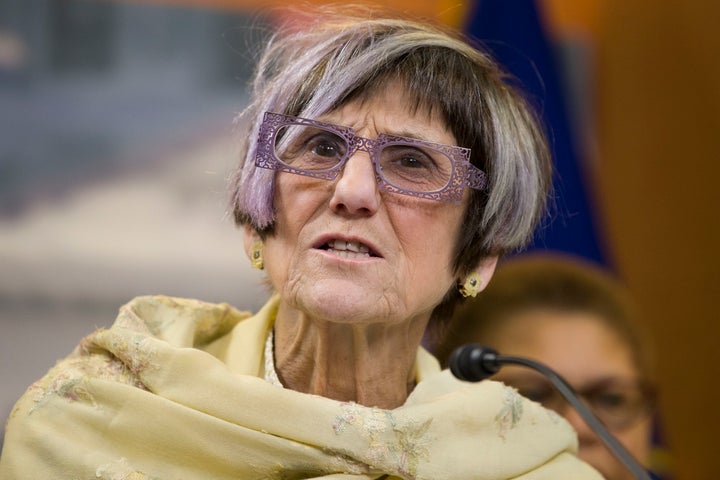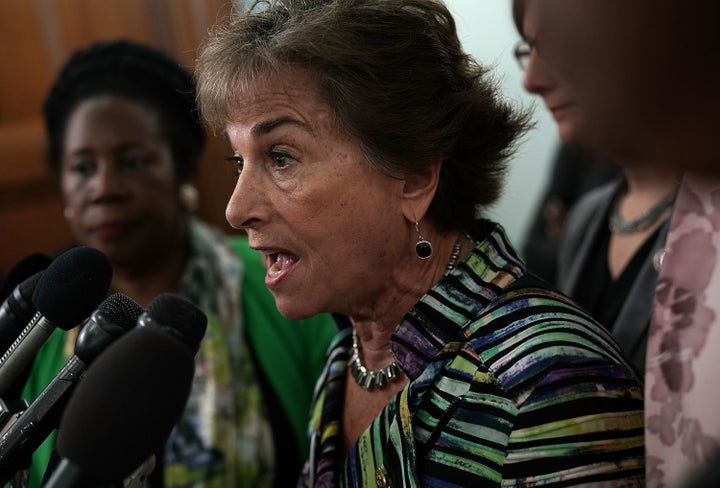Rosa DeLauro has been a member of the U.S. House of Representatives since 1991, which means she was there when Democrats tried to pass comprehensive health care legislation ― first unsuccessfully, when Bill Clinton was president, and then successfully, when it was Barack Obama’s turn. She took many lessons from those episodes, but one of the biggest was that threatening the insurance of people with good employer benefits is a terrible idea, no matter how appealing the new alternative sounds.
“There are 160 million people who get their insurance through their employer,” DeLauro, a Connecticut Democrat, told HuffPost recently. “You cannot tell them overnight that it is gone.”
Lots of Democrats are making similar argument these days as proposals to create a single-payer “Medicare for all” system get serious attention and scrutiny. The proposal getting the most attention right now comes from Bernie Sanders, the independent Vermont senator who made “Medicare for all” a centerpiece of his 2016 presidential campaign. House Democrats are working on a version of their own. Progressive supporters say the approach offers the most efficient way to make sure everybody can get affordable medical care ― plus, they note, it would mean ending private insurance hassles once and for all.
But enrolling everybody into a government-run insurance plan would also mean wiping away employer-sponsored coverage, and the available polling, consistent with DeLauro’s viewpoint, suggests the public would be wary. That is one reason even some Democrats who endorsed “Medicare for all” in the past are balking at committing to it now, while others are pushing explicitly to start much more slowly ― perhaps by taking one of the two big existing programs, Medicare or Medicaid, and opening them up to carefully targeted groups of people. An example is a new bill from several Democratic senators that would let people older than 50 buy into Medicare.
DeLauro, whose district includes some of the most liberal-leaning parts of New Haven, has bigger plans in mind. Along with another House Democrat, Jan Schakowsky of Illinois, DeLauro has put together a proposal that envisions more dramatic reforms than those limited Medicare or Medicaid expansion proposals would launch, even though it would stop short of the kind of immediate, wholesale transformation that “Medicare for all” would unleash.

The legislation, which DeLauro and Schakowsky are calling “Medicare for America,” would create a comprehensive, government-run insurance program that would replace the big existing federal programs as well as the private insurance policies that people today buy on their own. But large employers would get to keep offering private coverage, leaving employees with the choice of sticking with their company plans or moving to the new public option, where they could potentially get much lower premiums and out-of-pocket expenses.
Like any health care initiative, the DeLauro-Schakowsky bill would entail real and complicated trade-offs. A skeptical take on the proposal is that it’s just ambitious enough to carry the same political liabilities as something like the Sanders bill but not ambitious enough to carry its strengths. “Medicare for America” envisions less sweeping changes than “Medicare for all” does, but that could mean leaving in place more of the current system's waste and complexities.
A more optimistic read on the “Medicare for America” bill is that it could create a stable, well-functioning universal coverage scheme ― one that, with maybe a few adjustments, would offer Americans the kind of financial protection and convenience that many European systems do. The possibility might be enough to make the proposal an attractive landing spot for those Democrats who crave bold action but have qualms about “Medicare for all.”
Some Major Disruption, But Mostly For Half The Population
“Medicare for America” resembles some more skeletal proposals that have been in circulation for the past year or so ― from analyst and Shadowproof contributor Jon Walker, Yale University political scientist Jacob Hacker and the Center for American Progress (CAP). Those last two are not coincidental: DeLauro and Schakowsky worked with Hacker and CAP experts as they crafted the bill, which the lawmakers introduced in December.
The CAP role might rankle those progressives who consider the think-tank too timid or protective of the Democratic Party establishment. But Walker is well-known on social media for his sharp progressive posts, while Hacker is famous for his role developing, and then fighting for, a strong public option in the Affordable Care Act. All of them have long records of supporting government-run insurance, as do DeLauro and Schakowsky.
That political pedigree may explain why, for all the talk about minimizing disruption, “Medicare for America” would actually disrupt quite a lot. For starters, it would automatically enroll everybody who does not have employer-sponsored insurance into the newly constructed government program. That’s basically half the U.S. population, including people on Medicaid or Medicare as well as those who currently buy coverage on their own, whether directly from insurers or through the Affordable Care Act’s exchanges.

Transferring all of those people into a new government program is no small matter and something that proponents of major health care reforms (on the political right as well as the left) frequently overlook. Medicaid, in particular, has evolved considerably in its 50 years, as lawmakers have tacked on provisions in order to address the very specific needs of the program’s vulnerable populations, including the disabled and the elderly. A proposal that simply dumped these groups into a regular insurance program could easily leave them struggling to pay for care and support.
“Medicare for America” doesn’t appear to have that problem. DeLauro and Schakowsky worked closely with representatives of the disability community, who now praise the bill for its attention to their needs and its potential to improve access to care rather than diminish it. They cite, among other things, the high standard of support for people who use home- and community-based services (everything from help with bathing to job counseling) in order to live independently and stay out of institutions.
“This is really the first bill that considers long-term supports and services when it thinks about universal health care,” Nicole Jorwic, director of rights policy at The Arc, an organization for people with intellectual and developmental disabilities, told HuffPost.
A Big Role For Private Insurance
As for the basic medical coverage, “Medicare for America” would provide an insurance package that looks a lot like what the Affordable Care Act is supposed to provide, except that benefits would come directly from the government and would be considerably more generous. The difference is particularly stark for people making up to twice the poverty line, or about $50,000 in annual income for a family of four, because they would pay virtually nothing.
Above that income threshold, premiums and out-of-pocket expenses would gradually become more substantial. And although they would still compare favorably with the standard policies available through the Affordable Care Act, this is where the really big differences between the DeLauro-Schakowsky and Sanders approaches start to emerge.
In the kind of “Medicare for all” system that Sanders envisions, nobody would pay premiums and nobody would pay out-of-pocket costs, except for some token extra charges for people who buy brand-name drugs when cheaper, equivalent generics were available. This is a point of principle for progressives who think the financial burden of health care spending should be a collective responsibility exclusively (taxes finance the system) and who fear, with good reason, that high out-of-pocket spending penalizes the poor and sick.

Another conspicuous difference between “Medicare for America” and “Medicare for all” is the role of private insurance. “Medicare for America” would not only allow employers to keep offering private plans. It would also allow private insurers to keep offering so-called Medicare Advantage plans that roughly one-third of seniors now use instead of traditional Medicare ― and it would allow insurers to offer those plans to non-seniors as well.
Proponents of “Medicare for all” think that allowing private insurers to maintain this foothold preserves some of the worst parts of today’s health care system, in part because it means doctors and hospitals must still deal with multiple payers of services. One of the clearest benefits of “Medicare for all” is that it would vastly simplify billing, allowing hospitals to cut administrative staff and ultimately save the system money.
“Medicare for America” wouldn’t do that, at least to the same degree. Nor would it sever completely the attachment between employment and coverage: As long as some businesses kept offering plans, employers would have some role in employee benefits. Plus, there are a lot of data to suggest that government overpays insurers that provide Medicare Advantage plans, allowing them to make extra profits at taxpayer expense.
“Keeping the private insurance industry in the driver’s seat is simply too hazardous for our health care.”
- Adam Gaffney, Physicians for a National Health Plan
“The shenanigans and gaming of wasteful privatized Medicare plans have drained the public purse for decades,” Adam Gaffney, president of Physicians for a National Health Plan, told HuffPost. “The excess administrative costs, and profits, imposed by our fragmented system produce hundreds of billions of dollars in waste. And patients are ill-served by narrow networks of providers, and by copays and deductibles, all of which would be retained under this plan.”
“Keeping the private insurance industry in the driver’s seat is simply too hazardous for our health care,” Gaffney said.
“Medicare for America” supporters, by contrast, figure that most private plans from employers and through Medicare Advantage provide decent coverage ― good enough, at least, that the political cost of forcing people to give up those plans isn’t worth the potential upside. The key, they say, is using automatic enrollment at the workplace to make sure everybody really gets insurance, holding private plans to high standards, scrutinizing those Medicare Advantage plans more carefully and then making sure everybody has the opportunity to move into the public alternative ― where premiums and out-of-pockets could end up being a lot lower because of the sliding income scale.

This does not amount to a guarantee that people will get their current plans, as Obama infamously promised about the Affordable Care Act. It’s more like a vow to make sure everybody has access to coverage at least as good as most employer plans today ― with an openly stated hope that a well-performing public plan would either force private insurers to keep up or force them to abandon the business.
“For anyone who is frustrated with their private insurance, this plan would provide an immediate off-ramp,” said Topher Spiro, vice president for health policy at CAP. “The 150 million workers with employer coverage can move over at their own pace, whether they’re fed up with their private insurance right now or prefer to wait until the Medicare plan is proven to work well. ... In other words, private insurance would no longer be a necessity.”
As Charles Gaba, the Michigan-based analyst who runs ACAsignups.net, put it recently, the goal of “Medicare for America” is to make the new government program “mandatory for roughly half the country (those least likely to object) but completely optional for the other half (those most likely to object).”
Government Control Of Prices, In A Roundabout Way
A key ingredient in other nations’ successful health care systems, which reformers in this country frequently cite as models, is government control of budgets and prices. That’s why all of those countries are able to cover everybody with so much less money than the U.S. devotes to heath care.
“Medicare for America” proposes to fix this by, in effect, setting a loose upper limit on doctor and hospital charges while allowing the government to negotiate drug and medical device prices. It’s similar to the approach that “Medicare for all” would take, but it would be less direct and less aggressive.
Where the Sanders proposal envisions paying hospitals at current Medicare rates, for example, the DeLauro-Schakowsky bill would establish a payment baseline that’s 10 percent higher than Medicare’s. That would still be less than commercial coverage, and the result would put some pressure on hospitals to lower prices, but not as much pressure as a proposal like the Sanders bill would apply.
Without that pressure, guaranteeing comprehensive benefits for so many people who don’t have them would cost even more money. Exactly how much money is hard to say right now, and that is one reason it’s difficult to predict with any confidence how many “winners” and “losers” the plan would produce.
If the DeLauro-Schakowsky proposal gets serious attention, influential groups, such as unions, will watch closely to see what it would mean for their members, many of whom have employer benefits more generous than what “Medicare for America” as presently written would guarantee. Groups representing the elderly citizens will be equally vigilant, checking to see how the new coverage and costs would compare to what seniors see once they are on Medicare.
But those questions don’t need answers right away. With the new congressional session just starting, the presidential campaign still in its embryonic phase and opportunities to pass laws almost certainly two years away at least, bills and campaign proposals seem important primarily as markers politicians can use to signal their priorities and stake out early negotiating positions.
“For anyone who is frustrated with their private insurance, this plan would provide an immediate off-ramp.”
- Topher Spiro, Center for American Progress
DeLauro and Schakowsky are now updating their bill and plan introduce the revision within the next few weeks, only this time with co-sponsors ― and that should provide an interesting test of the concept’s strength, because the latest version of “Medicare for all” will be making its debut in the House at around the same time.
The old House version of the “Medicare for all” bill got 124 co-sponsors. Aides to Rep. Pramila Jayapal, the Washington state Democrat crafting its revision, have said their goal for now is merely to get more than 100 ― a sign, perhaps, that finding co-sponsors is getting a little harder now that an endorsement is more than symbolic.
As it happens, one House Democrat who plans to sign on is Schakowsky, even though she also remains committed to promoting the bill she wrote with DeLauro. “I will work towards passage of ‘Medicare for America’ in this Congress, as well as any other health reform proposals that improve health equity, access, and quality,” Schakowsky said. “With a new Democratic majority in the House of Representatives, I am glad we can finally work on building upon the Affordable Care Act instead of fighting endless Republican attempts to tear it down.”
DeLauro echoed those sentiments. Notwithstanding her misgivings about other plans disrupting employer coverage, she said, she is thrilled to see the conversation finally moving in a more progressive direction. And having been through this process twice before, she knows it is only just beginning. “There are different approaches,” DeLauro said. “I stand by mine and they stand by theirs. But we can have a conversation.”
